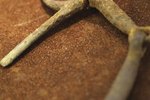
Your horse's bridle breaks the language barrier between you and your horse. It's a piece of equipment that, with proper training and use, allows even novice riders to convey what they want their horse to do in a way the horse can understand. A well chosen bit and bridle can be an extremely effective tool for the rider.
Western vs. English
Western bridles and English bridles are similar but not identical. English bridles have a slightly more complicated design and come standard with a headstall, cheek pieces, throat latch, nose band and brow band. Western bridles can feature just a head stall with cheek pieces. Not all western bridles feature brow bands or throat latches, although a throat latch is generally a feature of higher-end bridles. Nosebands are rarely seen in western disciplines.
Bits
Hundreds of different bits are available for purchase in the United States and around the globe. While some bits are distinctly English or Western, others -- like the snaffle -- can cross over between disciplines and riding styles. Some bits are more common than others and can range from being fairly gentle pieces of equipment to potentially dangerous if used by someone without adequate riding experience. Choosing the right bit depends on several factors, including the horse's mouth, training, sensitivity, temperament and riding discipline. It also depends on the rider's level of experience and his skill with his hands, leg and seat. A bit that works perfectly for one horse may be a bad match for another.
Bridle and Bit Care
You have to clean your bit and your bridle on a regular basis to keep your equipment in safe working condition. Bits should be rinsed with water after every ride and periodically sterilized. A good scrubbing with regular toothpaste works well to get built-up grime off the bit and leaves behind a taste horses normally find palatable when you put the bit back in. Leather bridles are cleaned using a good quality leather soap and conditioner. Regular cleaning will prevent them from cracking and keep the leather supple. Nylon bridles are cleaned with soap and water.
Hackamores
Not all bridles have a bit. The term "hackamore" is used to describe most versions of the bitless bridle. These bridles use pressure and leverage on the face, nose and poll to control the horse rather than pressure in the mouth. The most common types of hackamore are the sidepull, bosal and mechanical hackamore. While the bosal and sidepull are considered to be fairly gentle pieces of equipment, the mechanical hackamore can severely injure a horse if used improperly.
References
- HorseChannel.com: Hands-on Hackamore Training
- Horses and Horse Information: Handy Hackamores
- Dutchess Bridle and Saddle: Recommended Leather Care
- Horses and Horse Information: How to Save Your Hide: Tack Lasts Longer When It's Clean
- HorseChannel.com: Tack Cleaning Tips
- Pony Club: Tack Care
- The Ultimate Horse Site: The Hackamore
Photo Credits
-
Photodisc/Photodisc/Getty Images
Writer Bio
Jen Davis has been writing since 2004. She has served as a newspaper reporter and her freelance articles have appeared in magazines such as "Horses Incorporated," "The Paisley Pony" and "Alabama Living." Davis earned her Bachelor of Arts in communication with a concentration in journalism from Berry College in Rome, Ga.



